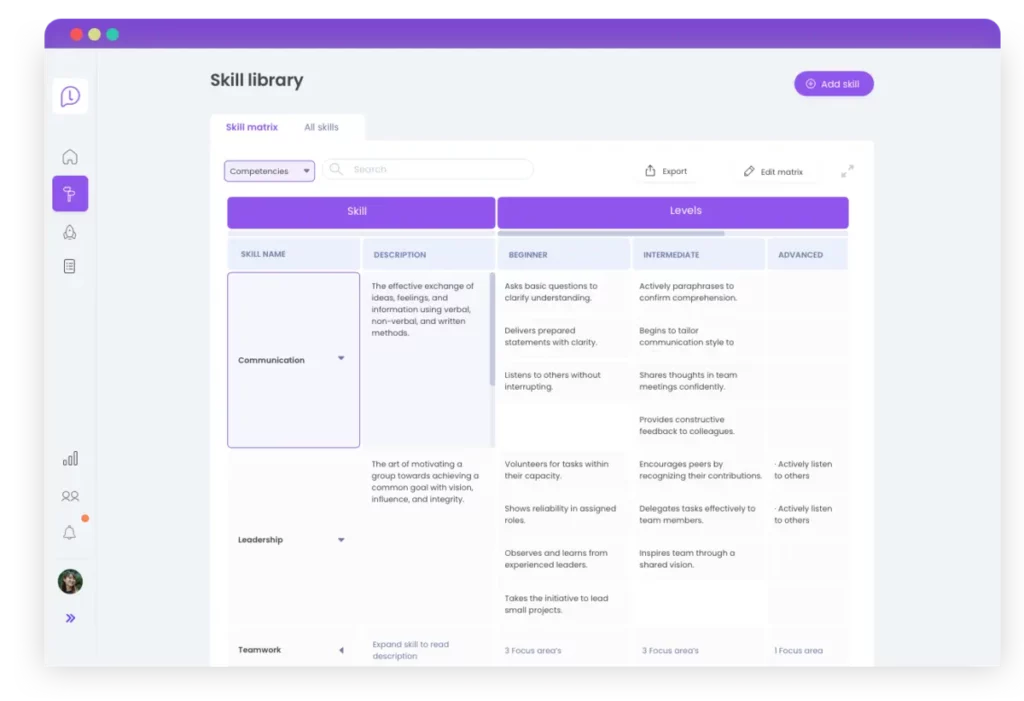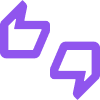We face a historically tight labor market. The danger of high staff turnover is high, as many employees are approached to “defect” to other organizations. That’s why more and more companies are coming up with the most creative ideas to keep employees engaged with their organizations, from smoothie bars to movie nights. So it is not surprising if you ask yourself the question: how do I retain my employees?
In this blog, we explain to you what employee turnover is, how to calculate it, what the hidden costs are and we give you 10 tips that will help you prevent or reduce high turnover. Are you curious about the costs of employee turnover in your organization? Then download the e-guide (calculator) right away in which you can easily calculate the hidden costs of turnover.
The significance of employee turnover
Employee turnover is the departure of employees within an organization. This includes both the natural and desired and undesired course. Employee turnover can result, for example, from an employee retiring, the expiration of a timely contract that is not renewed, or an employee resigning.
What is “desired” attrition?
Does the employee have low performance and little tangible knowledge? If so, it may be a godsend for the company to let this employee step down from the position and have someone more suitable replace them. Once the employee steps up, we call that desired turnover. In addition, in most cases, employees who retire are included in the desired turnover.
What is “unwanted” attrition?
Does the employee perform well and have a lot of hard-to-transfer knowledge? When such an employee leaves the company, there is unwanted turnover. Often this comes as a surprise to the employer. Although the cost of absenteeism can also be hefty, it does not fall under turnover. To do so, the employee must first leave employment.
What is the difference between internal and external attrition?
When an employee leaves the organization, we call it external turnover. But there are also employees, for example, who change positions within the organization or are promoted. These fall under internal turnover. With the current labor market we have today, external unwanted turnover in particular provides insight into the labor quality of the organization.
The labor market and its impact on employee turnover
The rate of employee turnover is now expected to be much higher than average as we struggle with a historically tight labor market. One reason for this is the aging population, but sick leave also had a record high of 6.3% at the beginning of 2022 (CBS, 2022). The current tightness and record number in job openings makes it more attractive for workers to look for another job (CBS, 2022).
Engaging the new generations is a challenge
According to the figures, the younger generation in particular changes jobs frequently:
-
- Millennials who do not feel heard at work are 21% more likely to leave their employer within one year (Deloitte, 2022).
- Nearly a quarter (24%) of Millennials expect to leave their employer within 2 years (Deloitte, 2022);
- Gen-Z’ers who do not feel heard at work are 9% more likely to leave their employer within one year (Deloitte, 2022);
- 4 in 10 Gen-Z’ers expect to leave their employers within 2 years (Deloitte, 2022).
Is labor market tightness structural?
For a while, the labor shortage seemed to have been solved by the large rounds of layoffs that took place the other day. These were a result of the energy crisis in our country. According to Matthijs Bouman, a journalist with the Financieel Dagblad, the labor shortage has been going on for much longer. He claims there has been higher unemployment and fewer job openings for 20 years. That, he says, is because of the many recessions in this century. He recommends continuing rigidly to invest in personnel and automations. The UWV also expects the labor shortage to ease slightly by 2023, but it is a structural problem that will persist for the next few years. Rob Witjes, head of the Labor Market Information and Advice Department at the UWV, says it is important for employers to realize that the tightness is structural. “They need to start adjusting to the tightness and personnel shortages and not be surprised by it.” He indicates: “This requires flexibility from employers in hiring, but also in keeping their own employees engaged and interested.”
What is the average employee turnover rate?
Average employee turnover was still at 18% in 2017, according to U.S. SHRM. In the Netherlands, data is only available from CBS on outflow by sector rather than total turnover. A healthy turnover rate is around 10%. Are you way above this? Then your organization has a high turnover rate.
Connection to prevent attrition
A higher chance of turnover occurs when employees feel no connection to their employer. GITP’s figures show this: an engaged employee is 87% less likely to leave. Want to know how to increase employee engagement? Scroll down for 10 tips to help you increase your employee engagement.
Costing employee turnover
To figure out whether it is necessary to take action, it is important to calculate the cost of employee turnover. Learn more about how to calculate your organization’s employee turnover here.
10 Tips to prevent employee turnover
There are many factors that can reduce unwanted employee turnover. We give you the most important and effective solutions.
1. Take a close look at the terms of employment
It is the foundation of every job: the conditions of employment. The salary is the most determining factor in this, because without the salary, the job would turn into a volunteer position. So make sure you communicate the salary clearly to your (new) employees. Is the salary average or above average? Then it can become binding on the employee. In fact, one in five workers (19%) will stay with the same employer if they grow more than five percent in salary next year (Visma-Raet). Can you completely reduce turnover with salary scales? No, but in combination with other working conditions for example, working days, flexible hours, hybrid working, a bonus system, pension plans, courses and by encouraging healthy behavior, you can make a good start as an employer. For example, 50% of employed people stay longer with their current employer if it institutes a four-day work week for the salary of a full-time work week (Visma-Raet).
2. Allow employees to work hybrid
With the increase in hybrid working, it is more difficult to ask staff to work full-time in the office. More and more organizations do require this, but it increases the likelihood of turnover. Indeed, the majority of workers (70%) want to combine office work with working from home, and 20% do not even want to return to the office at all (FNV, 2021). So the need for working from home is great. Offer working from home as an option. But note that there is then a greater challenge in encouraging contact between employee and manager. The younger generation in particular needs more companionable contact. In fact, Millennials have a strong preference for a coach rather than a manager (Gallup, 2016). And if they have a coach, it increases loyalty, causing 68% of millennials to stay with the company longer than 5 years. Of millennials without a coach or mentor, only 32% stay longer than 5 years.
Automation among the young generation
Patrick de Jong, System Engineering Manager at Palo Alto Networks Netherlands, advises automating tasks as much as possible. “Students are often exposed to machine learning and AI as well. They want to do something with that and they like to see it reflected in the workplace. Then when they get into the workplace and they do work that is too simple or can be automated, you don’t keep them on board for long.”
3. Improve your job postings
You can bring in a talent, the connection with the team is there and yet the new employee leaves. How is that possible? It could just be that the job posting did not match the actual position and company. International research among 9,000 employees shows that 91% are already considering leaving the company within a month, and in the follow-up probationary period, 93% of employees are considering it (Robert Half, 2018). Avoid disappointment and communicate clearly through the job posting what position(s) are involved, what the terms of employment are and who the new employee will be dealing with. Make sure the job posting is open and transparent and prevent unqualified and overqualified applicants from responding.
To avoid staff turnover, be honest about it:
-
- the role;
- working hours;
- the salary;
- the rewards.
Tip: mention the salary is the job posting. More and more companies are doing this.
4. Communicate clear expectations
Much frustration can arise when an employee does not know if they are “doing it right. By communicating expectations clearly, you build trust with your employee. This is a particularly important point for the younger generation: millennials and Gen-Z’ers have a strong need for a coach from the moment they start. Someone who cares about their well-being, acts ethically and communicates transparently (Gallup, 2021). Traditionally, organizations communicate expectations to their employees through job profiles. However, the world is changing so rapidly that the traditional job center is quickly becoming obsolete. More and more organizations are therefore choosing to design a job home based on skills. Another method of understanding expectations is to translate organizational goals into goals for each employee. This methodology works particularly well for departments where concrete targets are being managed, such as the sales department (read more about this in tip 7).
Design a skill-based job matrix for your organization
Give employees insight into what is expected in their jobs and where they can develop using a modern skill-based job matrix. Each employee sees directly what their responsibilities are and what competencies, knowledge areas and tools are required for the position.
-
- Learned offers profiles for more than 4,000 positions with a total of 100,000 skills;
- You can easily customize the profiles to fit your organization;
- Use your job matrix for objective development conversations, career paths and data-driven learning offerings.

With Learned, you make expectations and evaluations transparent. With the help of AI easily create market-based job profiles with objectives, competencies and skills. Explanatory image: This example shows the job profile for an HR manager. This profile and over 4,000 others are available for free in Learned. You will see how the success of this position can be measured and what behaviors are required for which competencies and skills. Try Learned now for 14 days for free!
5. Provide effective onboarding programs
The previously mentioned study by the recruitment consultancy Robert Half, among which 9,000 international workers participated in the survey, found that 9 out of 10 employees are already considering leaving their new employer during the trial period. Ultimately, 33% of employees actually quit during the trial period (Jobvite, 2018). Proper onboarding can prevent employee departures. By providing sufficient clarity, the employee knows where he or she stands. Proper familiarization can give the employee enough support to start working independently. And also, you can motivate the employee to connect with colleagues. By doing this at the beginning, you encourage engagement.
Create your own onboarding programs
Professionalize the onboarding of new colleagues or help employees moving on to another position quickly find their feet. With Learned, you create onboarding programs for your organization and/or specific positions.
-
- Easily create a structured path of information & activities for streamlined onboarding;
- Help managers save time by digitizing onboarding and avoid having to explain things over and over again;
- Have the end of probation meeting and record it in Learned. Monitor participants’ progression along their onboarding path.
6. Have conversations with a focus on development
Room for personal development is an important binding factor for employees. Many organizations get feedback from the Employee happiness survey (Employee happiness survey) or from exit interviews with departing employees that they need to pay more attention to employee development.
The HR cycle of conversations provides an opportunity to reflect more frequently on employee development. Research shows that employees who talked to their manager about their goals and successes in the past six months are up to 2.8 times more likely to be engaged at work(Gallup, 2020). Employees whose managers are willing to listen to their work-related problems are 62% less likely to experience burnout (Gallup).
Want more information about implementing a modern interview cycle? Then also download our e-guide: ‘The modern HR cycle’.
Conduct modern evaluation interviews with a focus on development
Encourage managers to actively engage in employee development during the year. Learned helps with templates and a skill-based job home to enable every manager to have a quality development conversation.
-
- Help managers conduct the evaluation interview with the relevant competencies and knowledge areas for the employee’s position;
- Managers and employees immediately see what learning offerings are available to help the employee;
- As HR manager, you maintain an overview of the conversations and development needs of employees.
7. Let employee make impact and contribute to the organization
If it is not clear to the employee how he or she can contribute to the organization, commitment will decrease. Among the young generation in Europe, 69% prefer a nice job to a top salary (Young Capital & Utrecht University). This means that they value their jobs more than just wanting to earn a living. So it is important to clarify how the employee can be influential. Yet a quarter of employees (28%) are not familiar with their company’s organizational goals (Protime, 2017) and other research shows that only 12% of Dutch employees feel engaged at work (Gallup, 2021). Work to be done! To understand the impact of the employee’s work, it is wise to clearly communicate company goals to the employee. Then set team goals and employee goals. This is a form of cascading. This makes it clear to the employee what his or her impact in the organization is.
Give employees insight into their contribution to organizational goals
Involve employees in organizational goals. Learned helps you translate organizational goals into goals per team and ultimately per employee.
-
- Easily set goals for the organization, teams and employees;
- Employees see visually how their goals have impact;
- As HR manager, you maintain an overview of progress.
Learned HR software usage survey – (Q3) 2021.
-
- 8 in 10 users found it easier to prepare and conduct interviews;
- 6 in 10 users make more calls;
- 8 in 10 users find conversations more valuable.
8. Provide ongoing feedback and compliments
Of all of working Holland, 15 to 20% say they do not experience recognition, attention or reward (Sparkler, 2022). Still, getting feedback is hugely important. Some 75% of all HR professionals report that feedback plays a role in encouraging behavior change. Feedback is also important in gaining insight into employee development potential and needs (69%), as input for appraisal and performance reviews (68%) and as a tool to increase employee engagement (67%) (GITP & Pi Company, 2019). Providing valuable feedback to employees creates a growth mindset in your organization. By doing so, you greatly encourage employee development. In Learned, you can give feedback using compliments. And in The Great Conversation, it is also possible to solicit feedback from the employee for the manager. This is to optimize cooperation.
Avoid surprises in the evaluation interview through ongoing feedback
With automatic reminders, Learned helps your managers provide feedback and compliments to their team members throughout the year. Create a feedback culture and avoid saving feedback until the evaluation interview.
9. Encourage development in current role or internal advancement
Of all employed people, 94% want to stay with a company if a good learning and development program is offered (LinkedIn, 2019). The need for learning is especially great among the younger generation of working people. LinkedIn’s survey found that about a quarter of Millennials and Gen-Z’ers found “learning” is the biggest reason what makes them happy at work. And more than a quarter (27%) of them said the reason for their departure was because of the inability to grow and learn. Therefore, make advancement opportunities transparent from the beginning and encourage internal mobility. In fact, opportunities to grow determine the likelihood of leaving. If, in addition to learning options, you offer employees the opportunity to change roles internally, the likelihood of leaving is even lower. After all, employees stay with their company about 41% longer if it regularly hires people internally (LinkedIn, 2020). They are then given the opportunity to grow.
Give employees insight into their career prospects within the organization
Encourage people to actively engage in their development and increase engagement. Learned gives employees insight into the skills and knowledge areas to be developed within their current role. In addition, Learned matches the employee’s profile with all available positions within your organization. This way, every employee has insight into the appropriate next steps.
-
- Concrete insight into what to develop in the current role or for the next step;
- Employees have insight into career paths within the organization;
- Link your learning offerings and encourage the use of your learning resources.
10. Measure job happiness on an ongoing basis
Is an employee constantly late for work? Or do you notice that he or she is demotivated? Perhaps you are not sure if he/she is being challenged enough. An employee’s behavior sends signals. Employee turnover is not completely preventable, but it can be predictable. For example, use an annual employee satisfaction survey or even weekly short pulse surveys to measure sentiment. That way, you’ll find out how engaged your employees still are and how they like the atmosphere. Based on the results, you can then engage with employees. By paying attention to the points they indicate longer motivation.
Real-time insight into employee engagement
Learned’s engagement add-on lets you measure engagement on an ongoing basis with short pulse surveys in addition to the annual Employee happiness survey.
-
- Measure sentiment on 6 key drivers of employee engagement;
- Real-time insight into your team’s engagement;
- Show that you are listening. Create action plans and communicate them directly to your team.




























